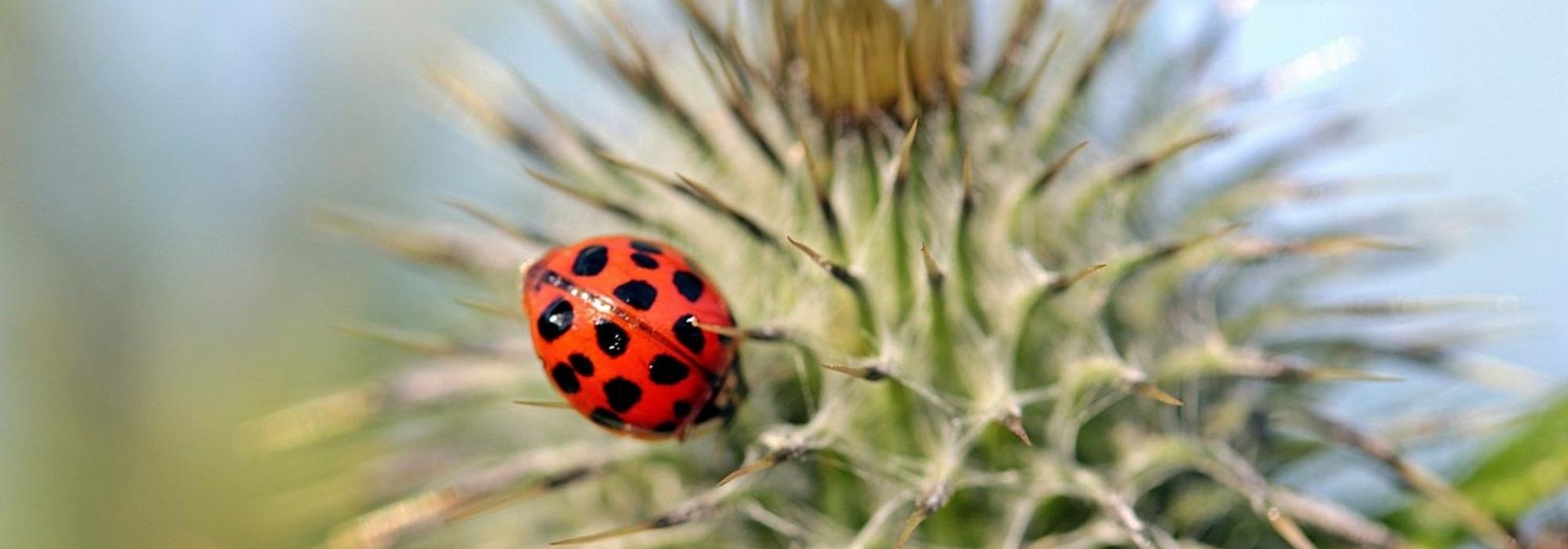
Organic pest control in the garden and vegetable patch: beneficial insects
Beneficial insects to the rescue of gardeners
Contents
Organic pest control allows, as its name suggests, the fight against unwanted organisms and crop pests in an ecological way. The aim is not to exterminate all that lives, but rather to regulate populations so they no longer become problematic. And for this we will need fauna: birds, mammals, spiders… but above all garden insects. These are the well-known beneficial insects! Organic pest control through beneficial insects therefore involves using insects to help preventively or actively combat garden pests and unwanted organisms. How can we turn them into allies or attract them into our gardens? We’ll tell you everything in this advice sheet.
Beneficial insects: how do they help us?
Beneficial insects can be classified into two categories :
- Predators : these are insectivorous species (larvae, adults or both) that feed on pests and thus directly limit their population ;
- Parasitoids : these are insects that lay their eggs in the larvae or in the eggs of their “prey“, the parasitoid will feed on the larva or the egg, which will also regulate any potential pest outbreak.
It goes without saying that in theory, all these beneficial insects should occur naturally and in sufficient numbers in every garden. In practice, this is not always the case. The best and simplest approach is to encourage their presence by creating a “sanctuary” in your garden : pond, hedgerow, natural meadow, dead wood… and of course a total ban on insecticidal products and the rest of the chemicals.
But one can also force the issue by artificially introducing native beneficials. Some dabblers have attempted this with exotic species, which later had harmful repercussions for nature : one example among many is the Asian ladybird.
Note : although much discussed in recent years, biological control using beneficial insects has been studied since the 18th century. The end of the Second World War and its wave of chemical products sounded the death knell for biological control.
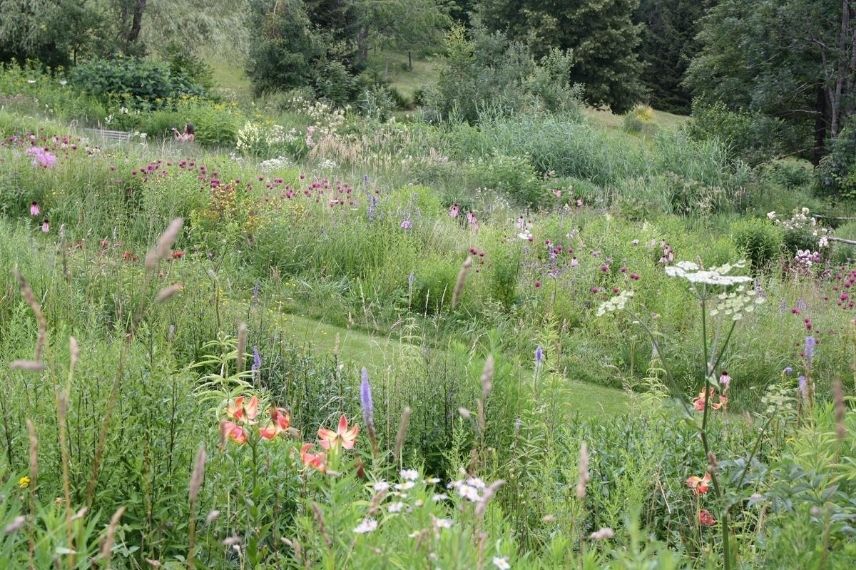
Natural garden should be favoured to provide shelter and food for numerous beneficial insects
Read also
Planting a hedge for insectsBeneficial insects for aphid control
Ladybirds
Probably the best-known of our beneficial insects: the adult “ladybird” — or even better, the larva — does an incredible job controlling aphids. A few ladybird larvae are often enough to curb an invasion.
To speed things up, try finding some in the wild, near the damp areas they particularly favour. You can also buy ladybird larvae from some garden centres or by mail order — they’re even more voracious!
Hoverflies
They’re not wasps, and certainly not bees! These insects (there are a great many species) are actually closer to flies (order Diptera). Nevertheless, they are very effective pollinators and their larvae are genuine little predators that feed on all kinds of aphids. To attract hoverflies to your garden you’ll need… flowers, flowers and more flowers. And to leave a ground cover through the winter and for much of the season: plant debris, mulch, dead leaves…
→ Find out more about hoverflies in our guide!
Lacewing larvae
The lacewing or gold‑eyed damsel (more poetic!) may look fragile and delicate, but it is nonetheless a particularly voracious predator of aphids. Both larva and adult can each devour hundreds of aphids in a single day. So much so that they are now sold to protect crops.

Ladybird, Hoverfly and Lacewing larva
Earwigs
Earwigs (forficules, pinch‑ears) are insects (order Dermaptera) recognisable by the pincers at the tip of their abdomen. They are totally harmless to us and to larger furry or feathered creatures, contrary to popular belief… However, they love caterpillars, aphids and other larvae such as codling moth larvae (carpocapsa). From time to time they nibble some fruit or damage certain flowers. But these small losses are easily outweighed by the predatory work of these friendly earwigs. To attract them, nothing could be simpler: an upturned terracotta pot filled with straw or dry grass placed on the ground near fruit trees does the trick!
Aphidius
Although very small, this representative of the order Hymenoptera is a particularly effective parasitoid. The female lays her eggs directly inside aphids. Once hatched, the larva has no choice but to consume the inside of the aphid. The aphid, however, remains alive only until the larva emerges to pupate and become an adult. There are many other species of micro‑hymenopterans that parasitise other larvae: notably those attacking cabbage whites or leaf‑mining caterpillars. They can be recognised at the parasitoid larva stage because the parasitised aphid swells to the size of a pinhead. The adult feeds on flower nectar, so having wild plants such as yarrow or certain Apiaceae (umbellifers) is a good way to attract them.
Wasps
Although many people have some fear of them, most wasps are perfectly peaceful — at least towards us… They do an incredible job as predators. Some social wasps consume nearly a thousand flies and as many caterpillars over their lifetime. For example, a solitary wasp of the genus Passaloecus will eat no fewer than 1,500 aphids during the few weeks of its life. If you want to attract predatory wasps, sow fennel!
Pemphredons
These are small hymenopterans of which around ten species can be found in our gardens. Females create brood cells and lay their eggs in hollow stems or pithy stems (as with black elder), in rotting wood, galls… To feed their young they stockpile paralysed aphids (and sometimes a few leafhoppers) inside the cells. As you can guess, to attract this insect to your garden all you need are a few hollow stems or branches, some dead wood and… a natural, not‑too‑tidy garden.
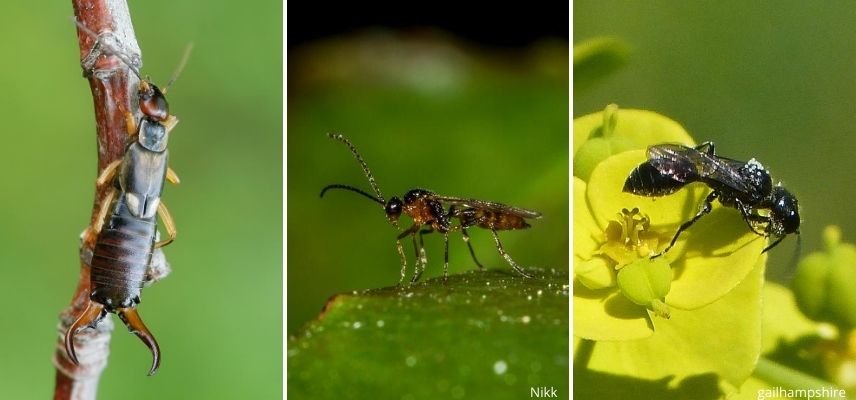
Earwig, Aphidius and Pemphredon
Beneficial insects versus other insects and gastropods
Carabids
These beetles have certainly earned their nickname “garden tiger“. They eat anything and everything, which makes them gardeners’ most valuable allies. They are in fact carnivorous, they eat insects, gastropods, mites… both as larvae and as adults. On the carabids‘ menu: slugs, snails, caterpillars, aphids, codling moths, red spider mites (tetranychus), Colorado potato beetles, leafhoppers, nematodes… but also species useful to garden such as earthworms or spiders. No matter, carabids (there are many species!) are perfect natural regulators of pest outbreaks.
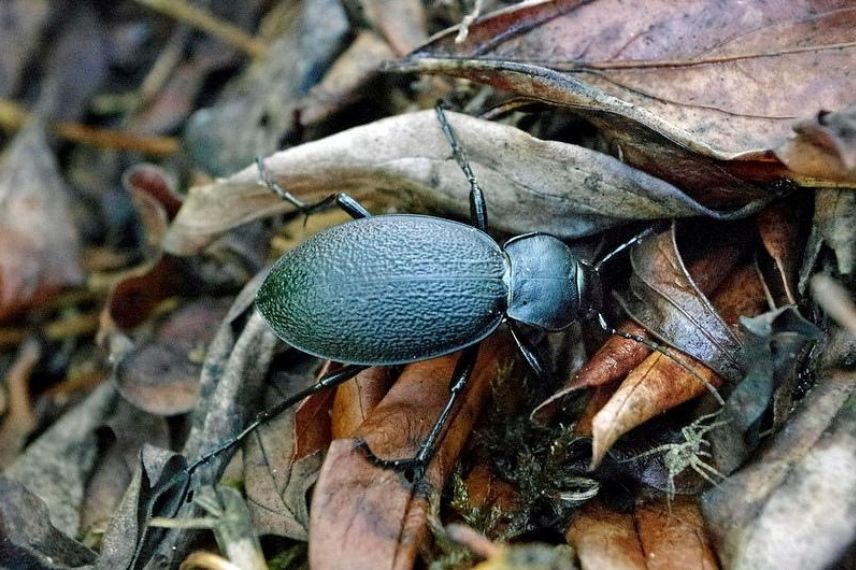
Carabid, another valuable insect, keen on slugs, snails and aphids
Rove beetles
Rove beetles do not go unnoticed. They are large black-blue beetles that will even try to intimidate by raising their abdomen if you surprise one in the vegetable patch. Well, obviously, this technique rarely works on gardeners. Nevertheless, this combative insect is a blessing for vegetable and ornamental gardens, as it is a master at hunting snails and slugs, and even feeds on their eggs. But that’s not all, it also relishes insect larvae, including those of the cabbage root fly. If you want rove beetles in your garden, simply cover soil and avoid over-tidying: a few dead leaves, a bundle of branches… will make them happy.
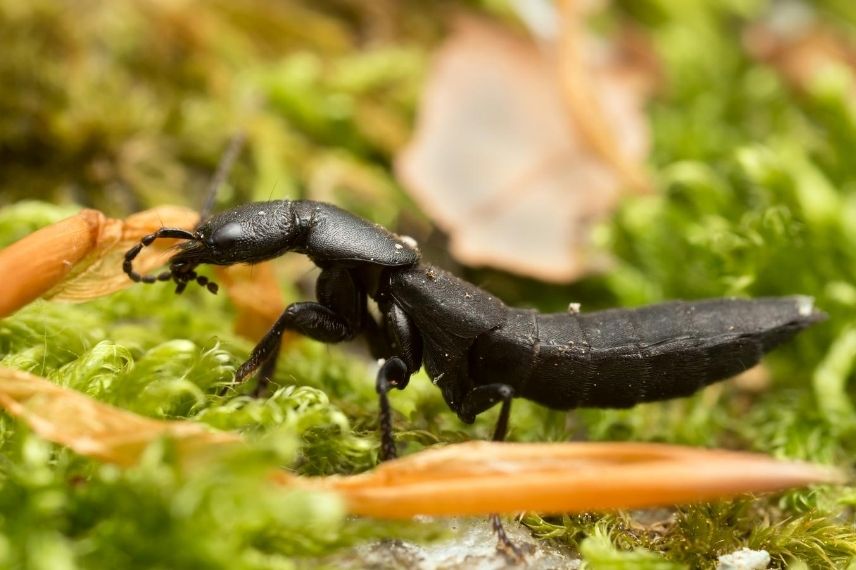
Rove beetle
Green bush-cricket
Bush-crickets are mainly carnivorous. When you are a large beast like the green bush-cricket, you either eat a lot or you eat “big”. The latter usually wins. The powerful jaws of the green bush-cricket will readily tackle large caterpillars or larvae of Colorado potato beetles. If you want them in your garden, there is little to do other than avoid digging where it is not strictly necessary. In fact, the female, recognisable by her caudal ovipositor (that sort of “sabre” at the end of the abdomen), lays her eggs in soil at end of summer. Not disturbing soil there will allow next generation to take care of your caterpillars.
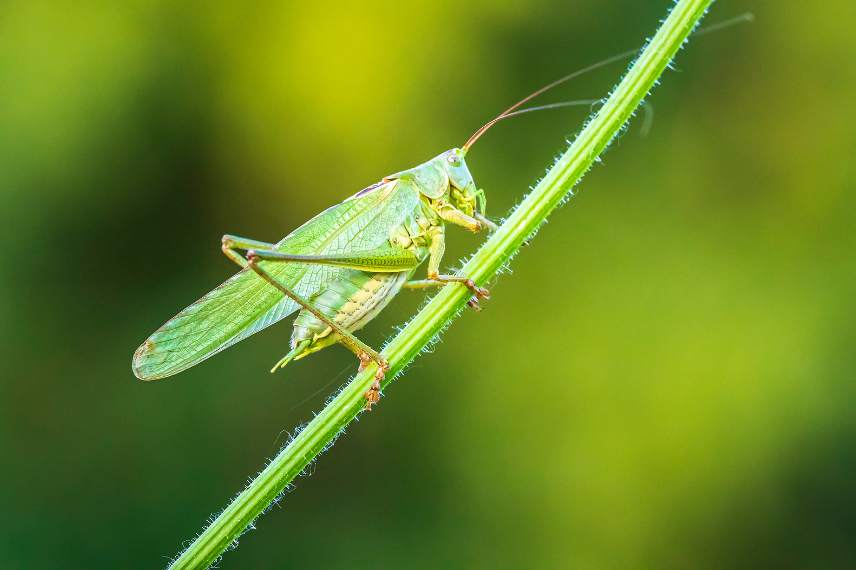
Tettigonia viridissima, largest green bush-cricket in Europe
Mites
They are not insects but arachnids like spiders (which, incidentally, also control unwanted insects). For some time now, a predatory mite from Chile, the Phytoseiulus persimilis, has been sold in garden centres. It attacks only the red spider mite, an acarid itself, also known as the two-spotted spider mite, a pest that spares few ornamental or vegetable plants. This small, shiny, round mite, coloured pink to bright red, can consume up to five adults and 20 eggs and larvae of spider mite. As it is a specialised predator, it will disappear in absence of its prey.
Read also
A natural hedge to enhance biodiversityTo learn more...
These few insects and other arthropods are of course only examples of beneficial insects among many others. One could add the bee‑fly, dragonflies, spiders (class Arachnida)… Not to mention other insectivorous animals: birds such as tits or warblers, mammals such as the shrew or even bats, as well as amphibious animals such as frogs or toads.
If you want support from a host of beneficial insects, you can choose to create an ecological garden. By creating a pond, a natural hedge, small natural shelters… Find all our tips to achieve this in: Design and lay out a natural and ecological garden.
Also see our advice sheet: Welcoming garden insects as well as our tutorial to build an insect hotel.
Finally, I recommend this excellent book on garden helpers published by Terre Vivante: Beneficial creatures in my garden!
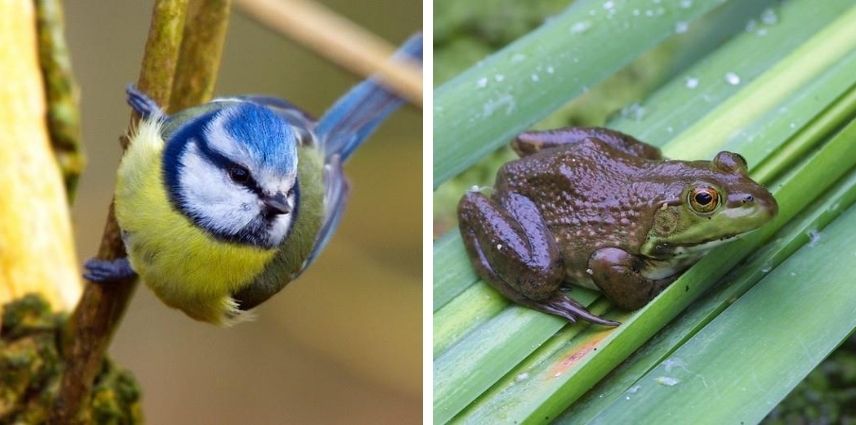
Tits and frogs also contribute very effectively to organic pest control in the garden!
- Subscribe!
- Contents
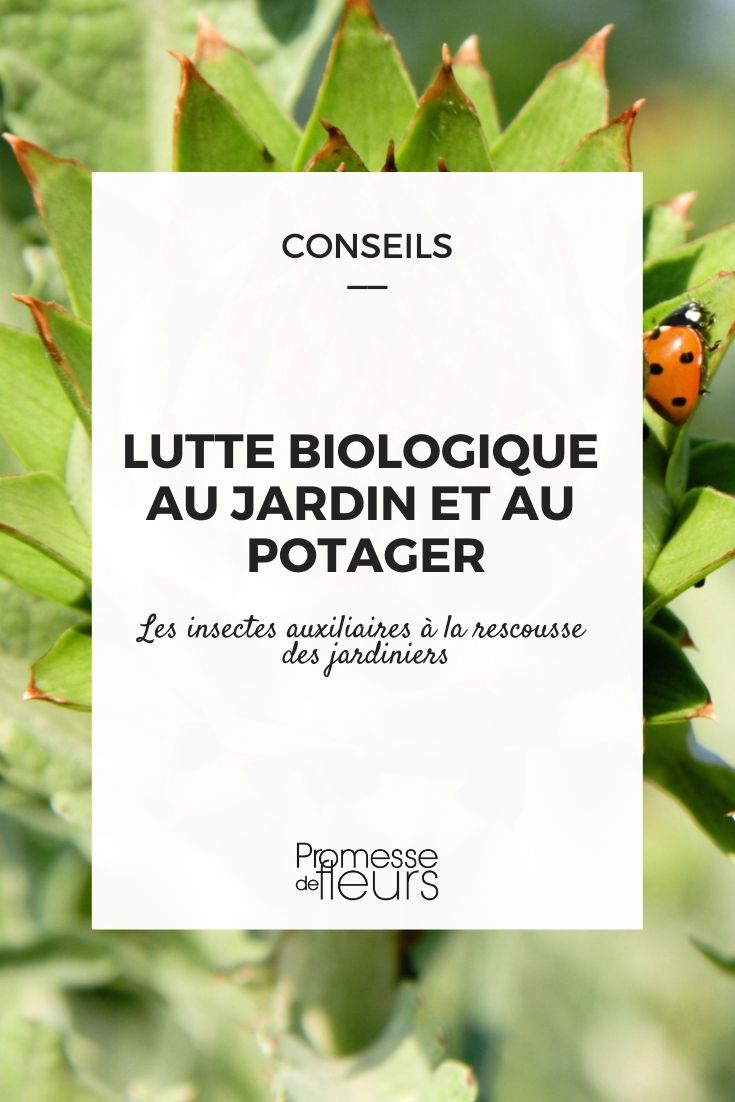































Comments